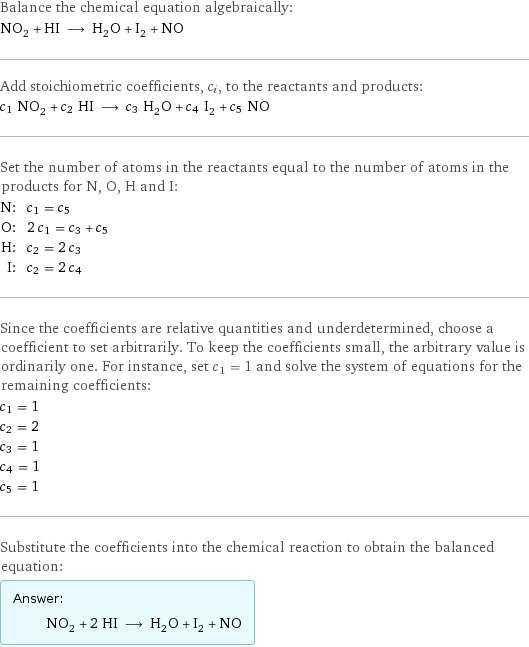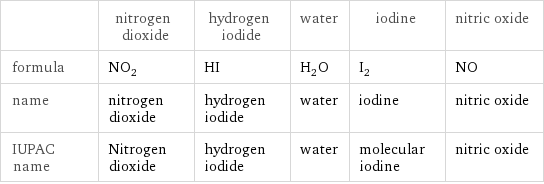Input interpretation

NO_2 nitrogen dioxide + HI hydrogen iodide ⟶ H_2O water + I_2 iodine + NO nitric oxide
Balanced equation

Balance the chemical equation algebraically: NO_2 + HI ⟶ H_2O + I_2 + NO Add stoichiometric coefficients, c_i, to the reactants and products: c_1 NO_2 + c_2 HI ⟶ c_3 H_2O + c_4 I_2 + c_5 NO Set the number of atoms in the reactants equal to the number of atoms in the products for N, O, H and I: N: | c_1 = c_5 O: | 2 c_1 = c_3 + c_5 H: | c_2 = 2 c_3 I: | c_2 = 2 c_4 Since the coefficients are relative quantities and underdetermined, choose a coefficient to set arbitrarily. To keep the coefficients small, the arbitrary value is ordinarily one. For instance, set c_1 = 1 and solve the system of equations for the remaining coefficients: c_1 = 1 c_2 = 2 c_3 = 1 c_4 = 1 c_5 = 1 Substitute the coefficients into the chemical reaction to obtain the balanced equation: Answer: | | NO_2 + 2 HI ⟶ H_2O + I_2 + NO
Structures

+ ⟶ + +
Names

nitrogen dioxide + hydrogen iodide ⟶ water + iodine + nitric oxide
Reaction thermodynamics
Enthalpy

| nitrogen dioxide | hydrogen iodide | water | iodine | nitric oxide molecular enthalpy | 33.2 kJ/mol | 26.5 kJ/mol | -285.8 kJ/mol | 0 kJ/mol | 91.3 kJ/mol total enthalpy | 33.2 kJ/mol | 53 kJ/mol | -285.8 kJ/mol | 0 kJ/mol | 91.3 kJ/mol | H_initial = 86.2 kJ/mol | | H_final = -194.5 kJ/mol | | ΔH_rxn^0 | -194.5 kJ/mol - 86.2 kJ/mol = -280.7 kJ/mol (exothermic) | | | |
Gibbs free energy

| nitrogen dioxide | hydrogen iodide | water | iodine | nitric oxide molecular free energy | 51.3 kJ/mol | 1.7 kJ/mol | -237.1 kJ/mol | 0 kJ/mol | 87.6 kJ/mol total free energy | 51.3 kJ/mol | 3.4 kJ/mol | -237.1 kJ/mol | 0 kJ/mol | 87.6 kJ/mol | G_initial = 54.7 kJ/mol | | G_final = -149.5 kJ/mol | | ΔG_rxn^0 | -149.5 kJ/mol - 54.7 kJ/mol = -204.2 kJ/mol (exergonic) | | | |
Equilibrium constant
![Construct the equilibrium constant, K, expression for: NO_2 + HI ⟶ H_2O + I_2 + NO Plan: • Balance the chemical equation. • Determine the stoichiometric numbers. • Assemble the activity expression for each chemical species. • Use the activity expressions to build the equilibrium constant expression. Write the balanced chemical equation: NO_2 + 2 HI ⟶ H_2O + I_2 + NO Assign stoichiometric numbers, ν_i, using the stoichiometric coefficients, c_i, from the balanced chemical equation in the following manner: ν_i = -c_i for reactants and ν_i = c_i for products: chemical species | c_i | ν_i NO_2 | 1 | -1 HI | 2 | -2 H_2O | 1 | 1 I_2 | 1 | 1 NO | 1 | 1 Assemble the activity expressions accounting for the state of matter and ν_i: chemical species | c_i | ν_i | activity expression NO_2 | 1 | -1 | ([NO2])^(-1) HI | 2 | -2 | ([HI])^(-2) H_2O | 1 | 1 | [H2O] I_2 | 1 | 1 | [I2] NO | 1 | 1 | [NO] The equilibrium constant symbol in the concentration basis is: K_c Mulitply the activity expressions to arrive at the K_c expression: Answer: | | K_c = ([NO2])^(-1) ([HI])^(-2) [H2O] [I2] [NO] = ([H2O] [I2] [NO])/([NO2] ([HI])^2)](../image_source/e93b6c65a00ba3252abc9a2b456b62d6.png)
Construct the equilibrium constant, K, expression for: NO_2 + HI ⟶ H_2O + I_2 + NO Plan: • Balance the chemical equation. • Determine the stoichiometric numbers. • Assemble the activity expression for each chemical species. • Use the activity expressions to build the equilibrium constant expression. Write the balanced chemical equation: NO_2 + 2 HI ⟶ H_2O + I_2 + NO Assign stoichiometric numbers, ν_i, using the stoichiometric coefficients, c_i, from the balanced chemical equation in the following manner: ν_i = -c_i for reactants and ν_i = c_i for products: chemical species | c_i | ν_i NO_2 | 1 | -1 HI | 2 | -2 H_2O | 1 | 1 I_2 | 1 | 1 NO | 1 | 1 Assemble the activity expressions accounting for the state of matter and ν_i: chemical species | c_i | ν_i | activity expression NO_2 | 1 | -1 | ([NO2])^(-1) HI | 2 | -2 | ([HI])^(-2) H_2O | 1 | 1 | [H2O] I_2 | 1 | 1 | [I2] NO | 1 | 1 | [NO] The equilibrium constant symbol in the concentration basis is: K_c Mulitply the activity expressions to arrive at the K_c expression: Answer: | | K_c = ([NO2])^(-1) ([HI])^(-2) [H2O] [I2] [NO] = ([H2O] [I2] [NO])/([NO2] ([HI])^2)
Rate of reaction
![Construct the rate of reaction expression for: NO_2 + HI ⟶ H_2O + I_2 + NO Plan: • Balance the chemical equation. • Determine the stoichiometric numbers. • Assemble the rate term for each chemical species. • Write the rate of reaction expression. Write the balanced chemical equation: NO_2 + 2 HI ⟶ H_2O + I_2 + NO Assign stoichiometric numbers, ν_i, using the stoichiometric coefficients, c_i, from the balanced chemical equation in the following manner: ν_i = -c_i for reactants and ν_i = c_i for products: chemical species | c_i | ν_i NO_2 | 1 | -1 HI | 2 | -2 H_2O | 1 | 1 I_2 | 1 | 1 NO | 1 | 1 The rate term for each chemical species, B_i, is 1/ν_i(Δ[B_i])/(Δt) where [B_i] is the amount concentration and t is time: chemical species | c_i | ν_i | rate term NO_2 | 1 | -1 | -(Δ[NO2])/(Δt) HI | 2 | -2 | -1/2 (Δ[HI])/(Δt) H_2O | 1 | 1 | (Δ[H2O])/(Δt) I_2 | 1 | 1 | (Δ[I2])/(Δt) NO | 1 | 1 | (Δ[NO])/(Δt) (for infinitesimal rate of change, replace Δ with d) Set the rate terms equal to each other to arrive at the rate expression: Answer: | | rate = -(Δ[NO2])/(Δt) = -1/2 (Δ[HI])/(Δt) = (Δ[H2O])/(Δt) = (Δ[I2])/(Δt) = (Δ[NO])/(Δt) (assuming constant volume and no accumulation of intermediates or side products)](../image_source/018546836efa808fec4102fd82f20e31.png)
Construct the rate of reaction expression for: NO_2 + HI ⟶ H_2O + I_2 + NO Plan: • Balance the chemical equation. • Determine the stoichiometric numbers. • Assemble the rate term for each chemical species. • Write the rate of reaction expression. Write the balanced chemical equation: NO_2 + 2 HI ⟶ H_2O + I_2 + NO Assign stoichiometric numbers, ν_i, using the stoichiometric coefficients, c_i, from the balanced chemical equation in the following manner: ν_i = -c_i for reactants and ν_i = c_i for products: chemical species | c_i | ν_i NO_2 | 1 | -1 HI | 2 | -2 H_2O | 1 | 1 I_2 | 1 | 1 NO | 1 | 1 The rate term for each chemical species, B_i, is 1/ν_i(Δ[B_i])/(Δt) where [B_i] is the amount concentration and t is time: chemical species | c_i | ν_i | rate term NO_2 | 1 | -1 | -(Δ[NO2])/(Δt) HI | 2 | -2 | -1/2 (Δ[HI])/(Δt) H_2O | 1 | 1 | (Δ[H2O])/(Δt) I_2 | 1 | 1 | (Δ[I2])/(Δt) NO | 1 | 1 | (Δ[NO])/(Δt) (for infinitesimal rate of change, replace Δ with d) Set the rate terms equal to each other to arrive at the rate expression: Answer: | | rate = -(Δ[NO2])/(Δt) = -1/2 (Δ[HI])/(Δt) = (Δ[H2O])/(Δt) = (Δ[I2])/(Δt) = (Δ[NO])/(Δt) (assuming constant volume and no accumulation of intermediates or side products)
Chemical names and formulas

| nitrogen dioxide | hydrogen iodide | water | iodine | nitric oxide formula | NO_2 | HI | H_2O | I_2 | NO name | nitrogen dioxide | hydrogen iodide | water | iodine | nitric oxide IUPAC name | Nitrogen dioxide | hydrogen iodide | water | molecular iodine | nitric oxide